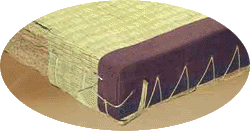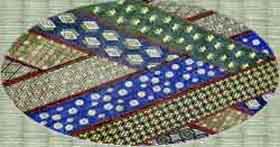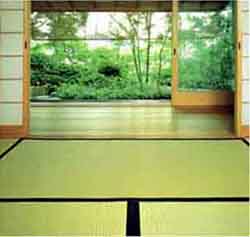| *** History of tatami and relation to Japanese Room washitsu. *** |
It is impossible to speak of Japanese culture without mentioning the existence of 'tatami' (thick mat made of rush), which provides comfort, diversity, spiritual richness for Japanese-style room, 'washitsu' - some call otherwise; 'zashiki', 'nihon-ma'('ma' means 'room' or 'compartment' in Japanese) - a room used for various purpose; living, dining, sleeping and so on. Tatami as well as washitsu is one of the sources of Japanese traditional culture. The manner of acting and etiquette in a room covered with tatami have deep liaison with our own morality and ethic.
Nowadays, we see some occidental people enjoying their lives on tatami. They usually lay one or two tatami mats on wooden or plaster floor and make seats, bed and so on. That is how Japanese tatami culture began. It is said that Japanese noblemen started using tatami on wooden floor as cushion or mattress more than one thousand years ago. Tatami-covered room is supposed to appear about six hundreds years ago during the Muromachi-era.This room style became popular among samurai, city craftworkers and merchants during the Edo era. | |
(Japanese Translation)
Nippon bunka wo kataru sai tatami ni tsuite furenai wakeniwa ikimasen.Tatami wa washitsu ( 'nihonma' 'zashiki' nadotomo yobaremasu.) to iu kyakuma syokudou shinshitsu nado tasaina youto ni mochiirareru kuukan ni yasuragi to futokoro no fukasa ya seishinteki yutakasa wo motarasete kuremasu.Tatami to washitsu wa nippon bunka no gensen no hitotsu nanodesu. Tatami jiki no heya deno sahou ya shitsuke nado wa nipponjin no doutokukan rinrikan mo menmitsu na tsunagari wo motituduke konnichi ni itatte imasu.
Kinnen seiyoujin no aida demo itabari ya shikkui no yuka no ue ni 1mai ka 2mai no tatami wo shiki suwattari nedoko wo tottari shite iru hito ga miuke raremasu.Kore wa nippon ni okeru shoki no tatami no mochiikata to onaji desu.1000 nen ijou mae nippon no kizoku wa itabari no yuka no ue ni tatami wo oki zabuton ya shiki futon gawari ni mochii mashita.Sou tatami bari no heya wa 600 nen hodo mae muromachi jidaini syutsugen shita mono to omoware masu.Kono heya no youshiki wa edo jidai ni bushi ya chounin kaikyu ni hiromari ippan teki ni natte yukimashita.
|
*** Function of tatami and Washitsu. ***
Washitsu is space that could be what users would like it to be. Tatami-covered washitsu is sometimes formal space with tension; meeting room with highly ranked priest in Buddhist temples, tea ceremony room, 'zashiki' room with 'tokonoma'; narrow hollow space, suggesting where in the room an upper seat is, in which we display picture, calligraphy and ikibana mostly to watch and enjoy. For everyday life, washitsu does offer open space for many neighbors or families to gather and to make themselves 'at home.' With a zataku table (low but large table to be seated without chair but cushion on tatami), this is a guest room. With futon only, you are in a sleeping room. Of course children and adolescents know well how to transform the same room into studying room; reading, writing, tea-ceremony rehearsal, ikebana.
As washitsu is usually divided into two or a few by 'shoji' - light sliding door mainly made of wood and paper, several small washitsu could, be united into a large hall by removing them. One more attraction. when opening shoji facing to the yard, our living space gets wider and opener to the green-rich, water-fragrant air. It is a good example of our philosophy; living with nature.
Tatami, made of natural products, is very good for human body in many ways. Its fragrance can, like one in the forest, tranquilize human nerve strain. It also conditions air. Paddy stem used for its core regulates humidity of the washitu. By eliminating nitrogen dioxide supposed to cause air-poisoning, its surface cleans up the air. Furthermore, it makes the room comfortable in each season, providing cool refreshing touch in summer and slight warmth by blocking cold wind coming up under the wooden floor in mid-winter. Besides, one of the best elements of tatami is physical adequate elasticity. It supports human body and relieves us of too much gravity and pressure. |
(Japanese Translation)
Washitsu wa tsukau hito no mokuteki shidai de dono younidemo henyou wo togeru kuukan desu.Tatamijiki no heya wa jiin no souryou no sekkennoma ya chashitsu 'tokonoma' tsuki no 'ozashiki' nado kakushiki ga ari kincho kan no tomonau ba nimo narimasu.Nichijo seikatstu no ba to shite wa kazoku ya kinrin no hito no tsudou yasuragi no basho toshite chouhou na ba tomo narimasu. Zataku wo okeba motenashi no kyakuma ni futon wo shikeba shinshitshu nisoshite ohana ya ocha no okeikoba nimo shosai nimo henshin shimasu.Washitsu wa taitei ki ya kami de dekita shouji (fusuma akarishoji) de hedate rarete ori korera wo ugokasu dake de sorezore dokuritsu shiteita kukan ga tachimachi oohiroma ni narimasu.Sara ni shouji wo akehanatsu dake de midori fukai niwa no keshiki wo heya ni mochikomi kuukan no hirogari wo kanji saseru koto ga dekimasu. Kono arikata wa shizen to tomoni ikiru to iu nippon tetsugaku no yoi rei de arimasu.
Tennen sozai de tsukurareta tatami niwa karada ni yasashii koto ga takusan arimasu.Tatami no kaori niwa shinrin no kaori to douyou no chinsei kouka ga aru to iwarete imasu.Mata tatami wa shizen no eakon sayou ga arimasu.Tatami-doko ni tsukawarete iru inawara wa shikke wo kyuushuu shitari houshutsu shitari to shitsunai no shitsudo wo chousei shi washitsu wo kaiteki ni shite kuremasu.Tatami-omote wa taiki osen no moto ni natte iru shitsunai no nisankachisso wo kirei ni shite kuuki wo jouka saseru hataraki wo motte imasu.Nippon no shiki nimo junnousei ga ari natsu no atsui hi niwa hinyari toshita kokochi yoi kanshoku wo motarashi huyuno samui hi niwa soto no tsumetai kuuki wo saegiri honokana atatakasa wo kanji sasete kureru no desu.Soshite seiza shitemo yoko ni natte iru toki demo tatami no motsu tekido na katasa ga karada wo sasaae kajuu na futan wo keigen shiteiru no desu.
|
*** How to make tatami. ***
Tatami is a Japanese-born flooring material functional for humid and temperamental climate. The size of a sheet of tatami is around 180 cm long and 90 cm wide, which is alternative depending on the region. In a room with eight tatami in largest scale, you can install another chest or closet than in smallest one. Each tatami consists of 'tatami-omote'(upside-surface),'tatami-doko'(core and downside to put on the wooden floor) and 'tatami-beri'(fringe). First, craftsperson sew straw and make it thick and strong enough to be tatami-doko. Then they cover it with tatami-omote woven with rush and hem with tatami-beri cloth. |  |
(Japanese Translation)
Tatami wa nippon dokutoku no kinouteki na yukazai de shitsudo ga takaku kion no henka no ooi nippon no fuudo ni mottomo tekishite imasu. 1 mai no ookisa wa yaku 180cm * 90cm. Tadashi chiiki ni yori bimyo ni ookisa ga tigatte ori onaji 8 mai no heya demo kagu hitotsu bun hodo no sa ga tsuku kotoga arimasu. Tatami wa omoni 'tatami-omote' 'tatami-doko' 'tatami-beri' de kousei sareteori wara wo nuikatamete tsukutta 'tatami-doko' wo igusa no kuki wo ori awaseta 'tatami-omote' de ooi 'tatami-beri' de fuchidori shimasu.
|
Tatami material 1:"Tatami-doko"
Tatami-doko is the core of tatami-mat, which is important to exhibit the practical feature and function of tatami as well as supporter of its apparent beauty and comfort. It is usually made of straw bed. Paddy stem is the most popular material. |
(Japanese Translation)
Tatami-doko wa tatami no shin ni atarimasu. Tatami toshite no tokusei kinou wo juubun ni hakki dekiruka douka washitsu toshite no utsukushisa yasuragi kan wo umidasu ka douka juyou na shinzai to ieru desyou. Sozai no syuryuu wa inawara de tsukurareta waradoko desu.
|
Tatami material 2:"Tatami-omote"
The atmosphere of washitsu depends on the quality of tatami-omote. Rush, perennial growing in damp, is used for it. Planted in mid-winter and cropped under the burning sun in summer, dried, they choose stems with enough thickness, length with good color for tatami-omote. Around 4.000 to 5.000 stems of rush are necessary to weave a sheet of tatami-omote. Today rush for tatami-omote is planted in fifteen regions in Japan. Every rush has its own color, splendor and strength. So it is used according to purpose. |
(Japanese Translation)
Tatami-omote no yoshi ashi wa washitsu sonomono no tatazumai wo sayuu shimasu. Genryou wa shicchi ni jisei suru tanen sei no igusa desu. Mafuyu ni uetsukerareta mono wo manatsu no enten ni karitori kanso shita ue de nagasa futosa iro nado ittei no kijun de erabi nukareta mono dake ga tsukaware masu. 1 mai no Tatami-omote wo tsukuru noni 4000 - 5000 hon no igusa ga tsukawarete imasu. Zenkoku 15 no chihou de saibai sare tatami-omote ni orarete imasu. Chiho dokutoku no shikichou koutaku ga ari youto ni yotte tsukai wakerare masu.
|
Tatami material 3:"Tatami-beri"
Tatami-beri (fringe) is very important both for decoration and maintaining durability. It sets simple beauty of tatami-omote off and gives formal tension to washitu. Tatami-beri is ordinarily order-made because it should be decorated, by the social ranking of the family to live in, with family color and 'kamon' (family crest) like hishi-mon, kikkou-mon, kikka-mon. Nowadays, new designs and color have been developed for tatami-beri according to change of our modern life style, so there are more than two thousands of design, which we can choose by our own taste. The material in highest quality is linen, though polyester is mainly used for mass production. |  |
(Japanese Translation)
Tatami-beri wa dezain wo takame taikyuusei nado kinou hoji no yakuwari wo hatashite iru taisetsu na sonzai desu. Sorebakarika tatami-omote no soboku na utsukushisa wo hikitatase washitsu no hirogari wo hikishimete kuremasu.
Ganrai Tatami wa kaoku kenchiku no sai chuumon ni oujite tsukurareta mono deshita. Sore wa mibun ni yotte irogara ga sadame raretari iekaku ni yotte sadame rareta monyou kamon ni yori soushoku sareru koto ga honshiki to sarete itakara desu. Tatami-beri no kihongara wa hishimon kikkoumon kikkamon nado no monberi desu. Saikin wa seikatsu youshiki no henka ni yori nennen atarashii dezain ya irogara ga kaihatsu sare gara no shurui wa yaku 20,000 nimo oyobi konomi ni oujite iro ya monyou wo erabu koto ga dekimasu. Sozai wa asanuno ga saikoukyu hin to sarete imasu ga tairyo seisan dewa poriesuteru nado ga shuryuu to natte imasu.
|
*** Conclusion. ***
Now you know better about our culture based on tatami. As mentioned above, this fine and delicate furniture is fabricated by weaving and tying up material in nature. Here you can see for Japanese culture 'tying' is one of the most important philosophy, which our 'mizuhiki' craft also stands for. |
(Japanese Translation)
Tatami to nippon bunka no kankei ni tsuite gorikai itadaketade shouka. Moushiagete ktia toori kono sensai de yuubi na seikatsu chodohin wa shizen no sozai wo ori musubi tsukeru koto ni yotte umare masu. Watakushi domo no 'mizuhiki' mo tatami mo kono 'musubu' to iu koui ga nippon bunka ni totte mottomo juyou na tetsugaku no hitotsu de arukoto wo shimeshite iru no desu.
|


